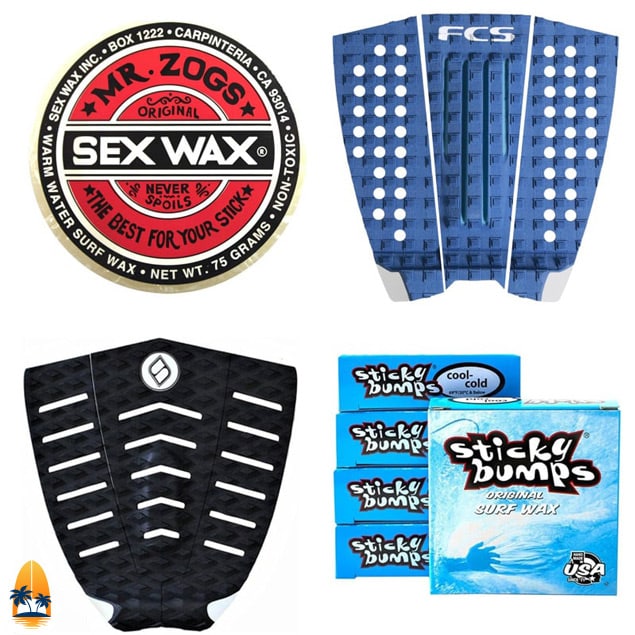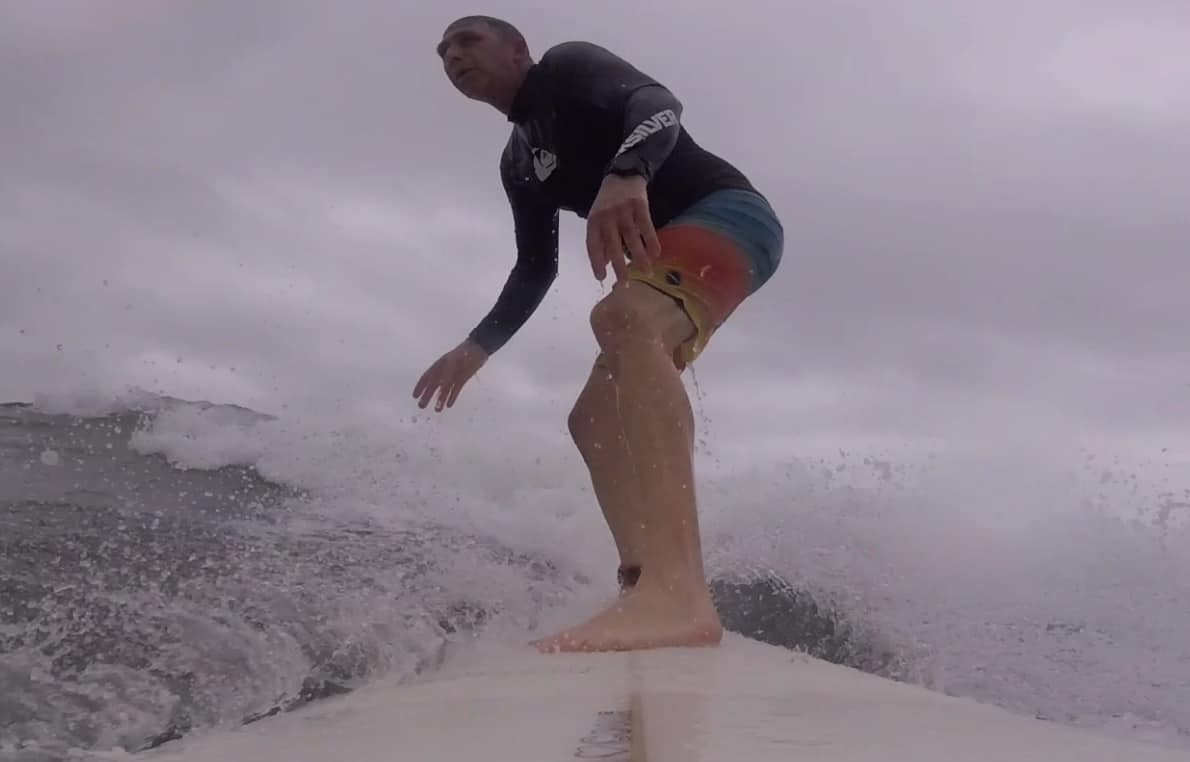When it comes to getting grip on your surfboard, you’ve got two main options: traction pads and wax. Both have their pros and cons, and some surfers even use a combination of both. In this post, we’ll break down the differences, the benefits of each, and how to choose what’s best for your board in the surfboard traction pad vs wax argument.
Wax:

Surfboard wax has been the go-to for surfers for decades. It’s rubbed onto the deck of your board to give you grip, which helps you stay stable while paddling and popping up on your board.
Pros:
- Customizable Grip: Wax allows you to apply it to just the areas of the board where you need grip, which can be personalized based on your riding style.
- Affordable: Wax is relatively cheap and you can get it at almost every surf shop in the world.
- Easy to Apply: With a few minutes of rubbing, you can have your board ready to go.
Cons:
- Maintenance Required: Wax wears off after a while, meaning you’ll need to slap more on from time to time. A wax comb will help you freshen up wax to make it last a little longer.
- Messy: Wax can get soft and sticky, making a mess in your car or on your board bag.
Traction Pads:

Traction pads, or deck grips, are made of foam and are attached to the deck of your surfboard with strong adhesive. Most surfers place them near the tail of their boards for back foot traction.
Pros:
- No Maintenance: Once you stick it on, you’re good to go. No need to worry about reapplying anything after each session.
- Great for Maneuvers: Traction pads offer a firm grip, especially for turns and tricks where back foot placement is key.
- Durable: A good traction pad can last for years without wearing out.
Cons:
- Less Flexibility: You can’t adjust or change where the pad is once it’s applied, unlike wax.
- Heavier than Wax: Although not significant, some surfers feel that pads add a bit more weight to their board.
Wax and Traction Pads: Can You Use Both?

Yes! A lot of surfers prefer to combine wax and a traction pad for the best of both worlds. Typically, they’ll apply a traction pad to the tail of the board for solid back foot grip, then wax the rest of the board for a more customized and versatile front-foot grip.
Why Combine Them?
- Improved Front Foot Grip: Wax offers a flexible grip for your front foot, making it easier to adjust your stance.
- Solid Back Foot Control: The traction pad ensures your back foot stays locked in place, especially during sharp turns.
- Customizability: This combination lets you add wax wherever you feel you need extra grip, while keeping the low-maintenance benefits of a traction pad.
Top Traction Pads Makers
When choosing a traction pad, you’ll want one that’s durable, provides excellent grip, and doesn’t peel off easily. Here are some top brands that are known for quality:
Creatures of Leisure: Known for their high-quality and innovative designs, Creatures of Leisure pads are a favorite among pros.
FCS: Offering a range of traction pads, FCS focuses on durability and performance, making them a top choice for many surfers.
Octopus: This brand offers some of the best-looking traction pads out there, without sacrificing grip or durability.
Gorilla Grip: Gorilla pads are popular for their high traction and stylish designs.
Channel Islands: These pads are known for their simple yet effective design and high-level performance.
Shop Surfboard Traction Pads At Amazon
Using the Right Wax for the Water Temperature
Choosing the right wax for the water temperature you’ll be surfing in is crucial for getting the best grip. For more info on different surf wax temperatures check out our guide!
- Cold Water Wax (below 58°F/14°C) remains soft in cold conditions.
- Cool Water Wax (58°F – 68°F/14°C – 20°C) is slightly firmer.
- Warm Water Wax (68°F – 75°F/20°C – 24°C) holds up in warmer waters.
- Tropical Water Wax (above 75°F/24°C) is firm enough to resist melting in hot weather.
Most wax brands, like Sticky Bumps or Sex Wax, will clearly label their products based on these temperature ranges, making it easy to find what you need.
FAQs: Surfboard Traction Pad vs Wax
Can I use a traction pad on a soft-top surfboard?
Yes, you can use a traction pad on a soft top board, but it’s important to ensure the surface is clean and dry before application. Not all traction pads stick well to soft tops, so look for ones specifically designed for these boards, or reinforce the adhesive with extra glue if needed.
How often should I reapply surfboard wax?
This depends on how often you surf and the water temperature. In warmer climates, wax can wear off more quickly and may need reapplying after every session. In cooler waters, it can last longer, but it’s still a good idea to refresh the wax every few sessions for optimal grip.
Do traction pads work better than wax?
Traction pads provide a firmer, more reliable grip for your back foot, especially during maneuvers like sharp turns and cutbacks. Wax, on the other hand, offers more flexibility and allows you to customize your grip for your front foot. It’s not a matter of one being better; it’s about your personal preference and surfing style.
Can I use both wax and a traction pad on the same board?
Absolutely! Many surfers use a traction pad for their back foot and wax for the rest of the board to get the benefits of both. This combination provides excellent back foot control and customizable front foot grip.
How do I remove an old traction pad?
To remove an old traction pad, use a hairdryer or heat gun to warm the adhesive. This softens the glue, making it easier to peel off the pad. After removing the pad, clean the leftover residue with rubbing alcohol or a specialized adhesive remover.
What happens if I use the wrong type of wax for the water temperature?
Using the wrong wax can make your board slippery. For example, cold water wax will melt and lose grip in warm waters, while tropical wax will feel too hard in cold water. Always choose wax that matches the water temperature you’ll be surfing in.
Can traction pads damage my surfboard?
If applied and removed properly, traction pads won’t damage your surfboard. However, removing them improperly (e.g., pulling without softening the adhesive) can strip away resin or leave marks. Always use heat and adhesive remover for safe removal.
Do traction pads add weight to my surfboard?
Traction pads do add a small amount of weight, but it’s usually negligible and won’t affect performance for most surfers. If you’re particularly sensitive to weight changes, this might be something to consider.
Can I apply wax over a traction pad?
You generally don’t need to apply wax over a traction pad since it’s already designed to provide grip. However, some surfers might wax the edges of the pad for a smoother transition between the pad and the rest of the board.
How do I choose the right traction pad?
Look for traction pads with durable materials, strong adhesive, and a design that suits your surfing style. Pads with arch bars and kick tails are great for surfers who like aggressive turns and maneuvers, while simpler designs work well for casual riding.
Conclusion On Surfboard Traction Pad vs Wax
Whether you go with wax, traction pads, or a combination of both depends on your personal preference and surfing style. If you want flexibility and don’t mind a bit of maintenance, wax might be your best bet. If you’re all about back foot control and low maintenance, traction pads are a solid choice. And for those who want a bit of both, combining them gives you the best of both worlds.


